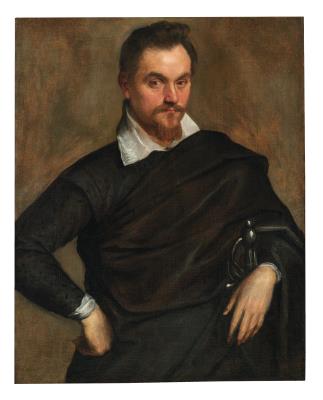Jacopo Negretti, called Palma il Giovane
(Venice circa 1548–1628)
Portrait of a nobleman, three-quarter-length, with a sword,
oil on canvas, 85 x 68.5 cm, framed
Literature:
G. E. Sperone et al., Portraits/Self-Portraits from the 16th to the 21st Century, exhibition catalogue, New York 2012, s. p. (as Jacopo Negretti, called Palma il Giovane)
Jacopo Negretti, known as Jacopo Palma il Giovane, was born into a Venetian family of artists. He presumably studied in the workshop run by his father Antonio and was later apprenticed in Rome, where he remained until about 1573. On his return to Venice, Palma’s work increasingly reflected his appreciation of the Venetian masters, particularly Titian and Jacopo Tintoretto, and after the latter’s death he became the most important painter active in the city.
This portrait is typical of Palma’s portraiture between the end of the 16th century and the early 17th century. During this period his simplification of space differs from Tintoretto’s style, as there is a lack of architectural elements and the use of a neutral background, in order to concentrate on the sitter, such as is apparent in the present composition.
It has been suggested that this painting must have been executed after the Self Portrait in the Pinacoteca di Brera and the Portrait of a Gentleman in the Art Institute of Chicago, dating from the mid-1580s, about the same time as the paintings Palma executed for the church of San Giacomo dell’Orto and for the Oratorio dell’Ospedaletto dei Crociferi in Venice.
The sitter in the present painting looks steadily at the viewer, his gestures are measured and carefully studied: the position of his arms is a typical of the nobility and the affected pose was conventional in portraits of the period. The light coming from the upper right and reflected mainly on the top of the sitter’s forehead is a subtle and effective device. The man’s clothes with the flat, white collar open on a closely fitted dark tunic that is only partly visible and characterized by a high, rounded neckline, shoulders with little padding and tapered sleeves, confirm the dating of this work. The sword confirms this unknown figure’s noble rank.
Specialist: Mark MacDonnell
 Mark MacDonnell
Mark MacDonnell
+43 1 515 60 403
mark.macdonnell@dorotheum.at
25.10.2023 - 18:00
- Realized price: **
-
EUR 42,375.-
- Estimate:
-
EUR 15,000.- to EUR 20,000.-
Jacopo Negretti, called Palma il Giovane
(Venice circa 1548–1628)
Portrait of a nobleman, three-quarter-length, with a sword,
oil on canvas, 85 x 68.5 cm, framed
Literature:
G. E. Sperone et al., Portraits/Self-Portraits from the 16th to the 21st Century, exhibition catalogue, New York 2012, s. p. (as Jacopo Negretti, called Palma il Giovane)
Jacopo Negretti, known as Jacopo Palma il Giovane, was born into a Venetian family of artists. He presumably studied in the workshop run by his father Antonio and was later apprenticed in Rome, where he remained until about 1573. On his return to Venice, Palma’s work increasingly reflected his appreciation of the Venetian masters, particularly Titian and Jacopo Tintoretto, and after the latter’s death he became the most important painter active in the city.
This portrait is typical of Palma’s portraiture between the end of the 16th century and the early 17th century. During this period his simplification of space differs from Tintoretto’s style, as there is a lack of architectural elements and the use of a neutral background, in order to concentrate on the sitter, such as is apparent in the present composition.
It has been suggested that this painting must have been executed after the Self Portrait in the Pinacoteca di Brera and the Portrait of a Gentleman in the Art Institute of Chicago, dating from the mid-1580s, about the same time as the paintings Palma executed for the church of San Giacomo dell’Orto and for the Oratorio dell’Ospedaletto dei Crociferi in Venice.
The sitter in the present painting looks steadily at the viewer, his gestures are measured and carefully studied: the position of his arms is a typical of the nobility and the affected pose was conventional in portraits of the period. The light coming from the upper right and reflected mainly on the top of the sitter’s forehead is a subtle and effective device. The man’s clothes with the flat, white collar open on a closely fitted dark tunic that is only partly visible and characterized by a high, rounded neckline, shoulders with little padding and tapered sleeves, confirm the dating of this work. The sword confirms this unknown figure’s noble rank.
Specialist: Mark MacDonnell
 Mark MacDonnell
Mark MacDonnell
+43 1 515 60 403
mark.macdonnell@dorotheum.at
|
Buyers hotline
Mon.-Fri.: 10.00am - 5.00pm
old.masters@dorotheum.at +43 1 515 60 403 |
| Auction: | Old Masters |
| Auction type: | Saleroom auction with Live Bidding |
| Date: | 25.10.2023 - 18:00 |
| Location: | Vienna | Palais Dorotheum |
| Exhibition: | 14.10. - 25.10.2023 |
** Purchase price incl. buyer's premium and VAT(Country of delivery: Austria)
It is not possible to turn in online buying orders anymore. The auction is in preparation or has been executed already.

